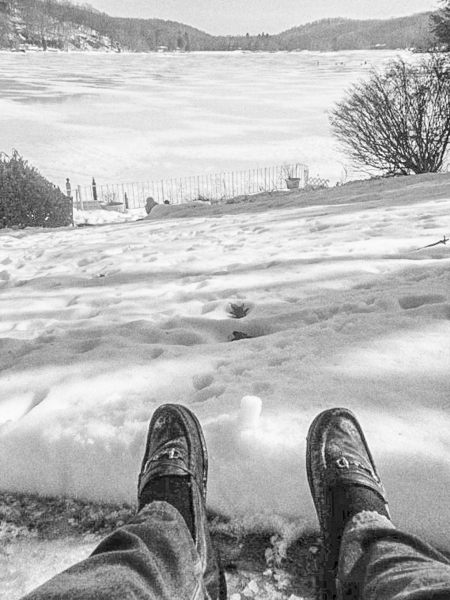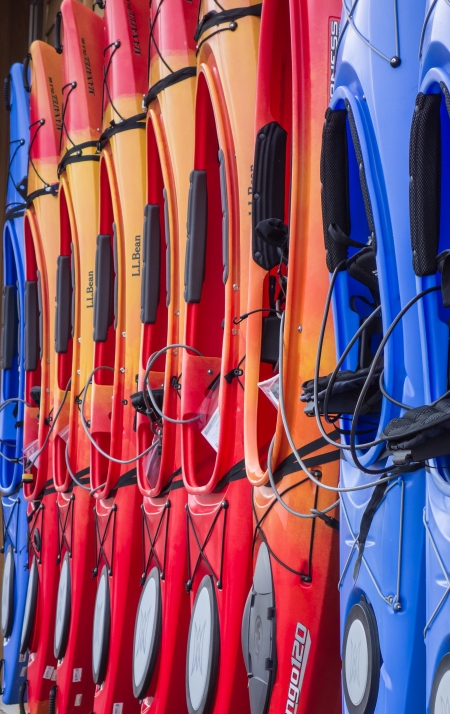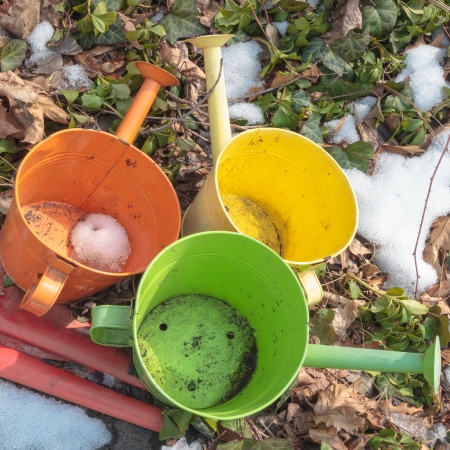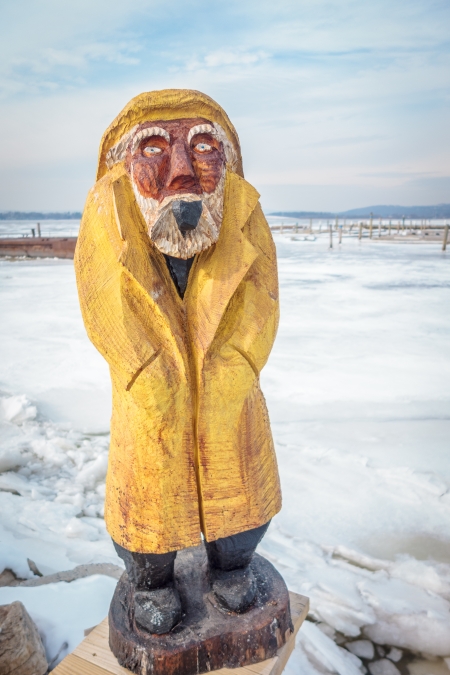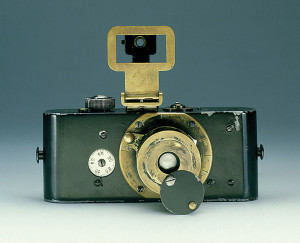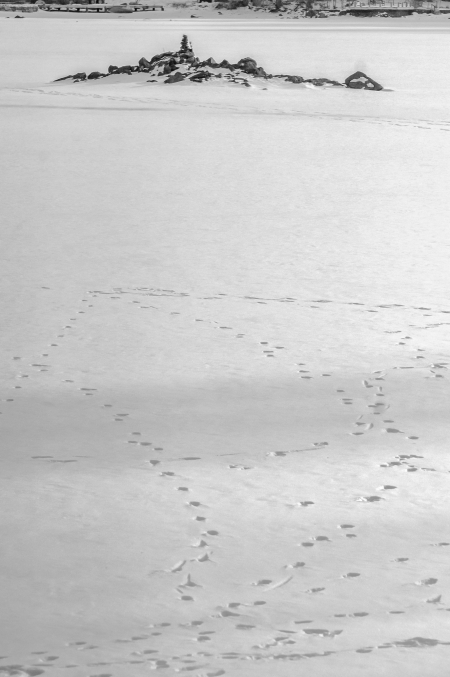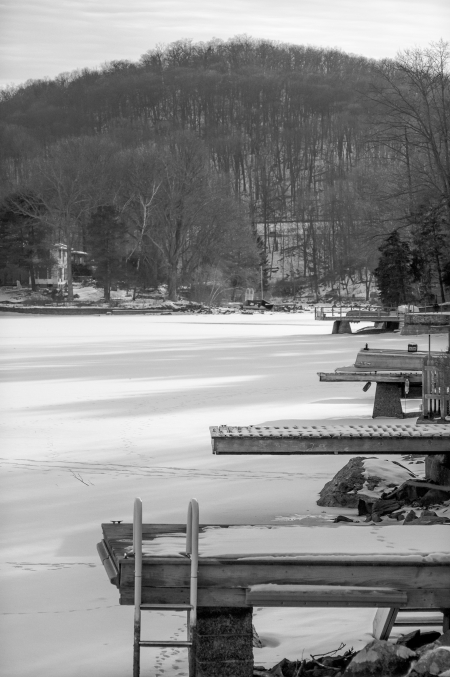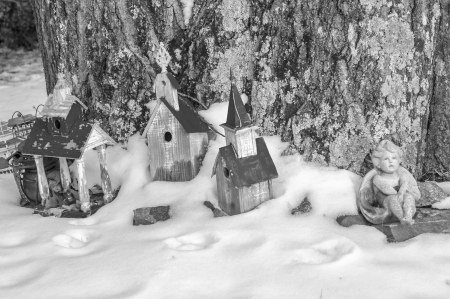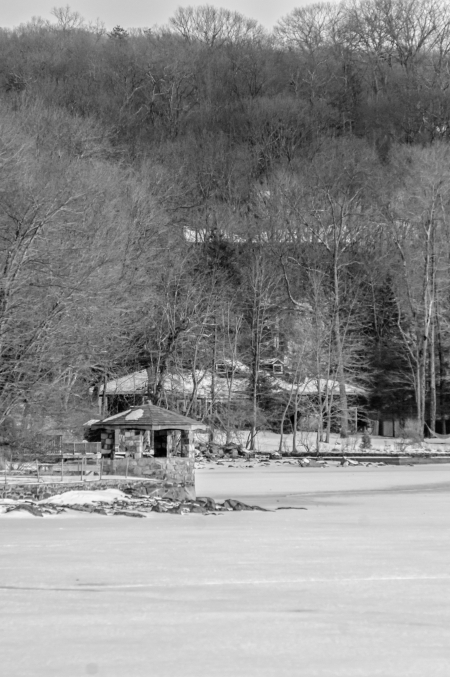We’re having some lovely weather today – sunny with temperatures in the 60s. It really feels like spring. The ice has been steadily melting on the lake and now it’s almost gone. This morning the ice went almost to our dock. Now, as I sit outside on the patio it’s disappearing before my eyes. I’m sure it will be gone completely by the end of the day.
Finally a nice day
The Weather Channel (if you believe anything that they say) is threatening a “potential” significant storm towards the middle of next week. For now though the weather is gorgeous: around 50 degrees Fahrenheit. There’s still quite a bit of snow on the ground, but I was able to dig a path to our two Adirondack chairs where I sat for a couple of hours looking at the lake and watching the people on the lake who were, I think, trying to cut holes in the ice so that they could fish. Jackson wandered around for a while until he sat down on the snow (looked awfully cold) so I got out his dog bed and put it on one of the chairs. He jumped up and seemed to be very comfortable. After a couple of hours the sun started to go down and I set off to go in. Jackson didn’t want to budge so I had to pick him up and carry him in. I guess he was enjoying it.
Although I have a house full of cameras I had my antediluvian iphone 3GS with me so I used that.
Some rare (at least for me) color pictures
Self portrait with buses.
I’ve written in other posts that I prefer black and white and that I have a poor feel for color photography. From time to time though…
Canoes in front of L.L. Bean
Watering cans along Revolutionary Road
Fountain at Danbury Fair Mall
Wooden Statue near Shattemuc Yacht Club, Ossining. Even this guy looks cold
One hundred years and going strong – Happy Birthday Leica
From The Guardian, Eamonn McCabe, Sean Smith, and Denis Thorpe talk about the importance of the Leica on the 100th anniversary of the creation of the original prototype. McCabe starts off with this comment:
Now that we all carry cameraphones in our pockets, it’s hard to imagine that the biggest breakthrough in photography actually happened back in 1914 – when Oskar Barnack invented the Leica.
Suddenly, photographers could throw away their heavy tripods and exploding flashguns, and step out of their studios to walk the streets and take photographs with this new mobile camera.
Barnack, a German optical engineer who specialised in microscope research, was also a keen amateur photographer, but his health was poor and he couldn’t carry the heavy cameras of the time. He quickly turned his prototype Ur-Leica into a lasting success. By 1932, there were 90,000 cameras. By 1961, a million cameras were in use.
via Happy 100th birthday, Leica! | Art and design | theguardian.com.
New Lens – Same old pictures
One of our neighbors is going to live in California. We went to their moving sale and they had a couple of old cameras. One was a nice looking Taron VL. Nice looking was about all you could say about it because, unfortunately, it was completely frozen. Too bad.
There was also a Minolta X-370 with a couple of lenses. I already had the 50mm F1.7, but while optically very nice mine left a lot to be desired cosmetically. This one was in very nice condition. The second lens was a Kiron 80-200mm F4.5 Macro zoom. I’d heard that Kiron lenses were generally pretty good. Wikipedia has this to say about them:
Originally, Kino Precision manufactured some of the now-famous Series 1 manual focus lenses under contract for Vivitar, a U.S. lens distributor of after-market film lenses for 35mm cameras. However, after the positive reception from consumers on Vivitar Series 1 lenses, the company believed the time was right to successfully market lenses to fit existing 35mm Japanese film cameras under their own brand, Kiron. Kiron soon became known as one of the very few after-market lens manufacturers that could supply products equal to or even exceeding the optical and mechanical quality of the original manufacturer. In particular, the Kiron 28mm/2.0, the 105mm/2.8 1:1 macro,[2] the 28-210mm/4.0-5.6 and the 3.8-5.6 varifocal zoom, and the 28-85mm/2.8-3.8 varifocal macro zoom lenses were praised in contemporary reviews of the day for their superb optical resolution and clarity, as well as mechanical quality.
This one seemed to be in pretty good shape except for a “cleaning mark” on the front element (I later discovered that rather than being a “cleaning mark” it was actually just a smudge easily removed with some lens cleaning fluid). I asked him how much he wanted and he said that I would know better than he. As this wasn’t the case, and we were in a bit of hurry to get somewhere else I said that I’d do a bit of research and get back to him later in the day. So after browsing around a bit on the internet I came up with what a thought was a reasonable amount and late in the afternoon I was back to pick up the goodies.
Then of course I wanted try something out. I didn’t have batteries for the camera and I already knew what the 50mm could do. So I decided to try the Kiron (on a Sony NEX 5n). Conditions were not ideal. It was late afternoon and getting dark quickly. I’d been carrying something heavy and my left arm was shaking. Below are some pictures.
It’s a solidly built one touch zoom. The F4.5 aperture is not particularly fast, but it is constant throughout the zoom range. While not as heavy as some I’ve seen it’s still a fairly hefty lens, although not really that big. It has a nice feature I hadn’t come across before: a zoom lock. Once you’ve chosen your focal length you can lock it so that as you focus the focal length does not inadvertently change. It does have quite a bit of chromatic aberration, which is easily corrected in Lightroom.
I was hand holding (too lazy to get my tripod) and so there was quite a lot of camera shake. Generally though I could see that the results were potentially good given the right conditions.
The camera and both lenses were in very good condition and came with a camera case and a nice lens case for the Kiron. Both cases were in very good condition. I paid next to nothing for all of this so all things considered I was very pleased with my purchase.
Sorry for the same old pictures. As is often the case when I’m testing something new I choose the path of least resistance and take pictures in my garden. So the birdhouses and the gazebo across the lake often appear. The other two pictures, from our dock do, at least, add a little variety.
Docks
Birdhouses and small angel
Lake and gazebo


